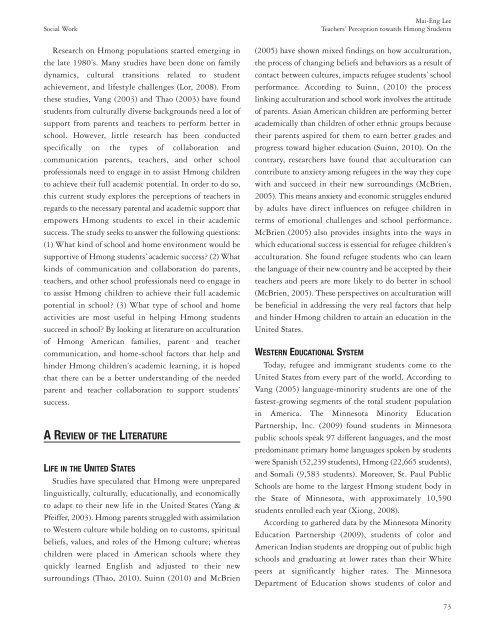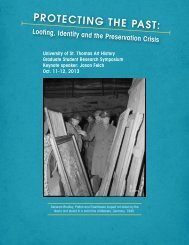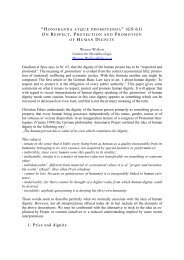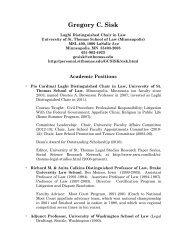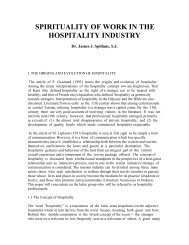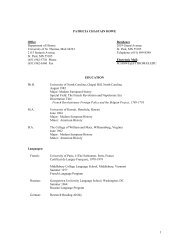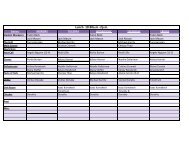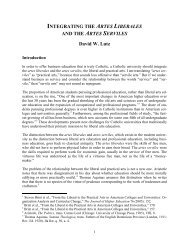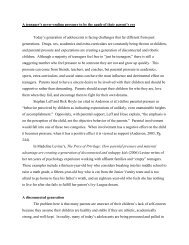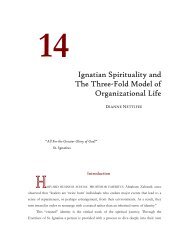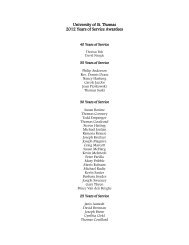dr. ronald e. mcnair acknowledgements - University of St. Thomas
dr. ronald e. mcnair acknowledgements - University of St. Thomas
dr. ronald e. mcnair acknowledgements - University of St. Thomas
Create successful ePaper yourself
Turn your PDF publications into a flip-book with our unique Google optimized e-Paper software.
Mai-Eng Lee<br />
Social Work Teachers’ Perception towards Hmong <strong>St</strong>udents<br />
Research on Hmong populations started emerging in<br />
the late 1980’s. Many studies have been done on family<br />
dynamics, cultural transitions related to student<br />
achievement, and lifestyle challenges (Lor, 2008). From<br />
these studies, Vang (2003) and Thao (2003) have found<br />
students from culturally diverse backgrounds need a lot <strong>of</strong><br />
support from parents and teachers to perform better in<br />
school. However, little research has been conducted<br />
specifically on the types <strong>of</strong> collaboration and<br />
communication parents, teachers, and other school<br />
pr<strong>of</strong>essionals need to engage in to assist Hmong chil<strong>dr</strong>en<br />
to achieve their full academic potential. In order to do so,<br />
this current study explores the perceptions <strong>of</strong> teachers in<br />
regards to the necessary parental and academic support that<br />
empowers Hmong students to excel in their academic<br />
success. The study seeks to answer the following questions:<br />
(1) What kind <strong>of</strong> school and home environment would be<br />
supportive <strong>of</strong> Hmong students’ academic success? (2) What<br />
kinds <strong>of</strong> communication and collaboration do parents,<br />
teachers, and other school pr<strong>of</strong>essionals need to engage in<br />
to assist Hmong chil<strong>dr</strong>en to achieve their full academic<br />
potential in school? (3) What type <strong>of</strong> school and home<br />
activities are most useful in helping Hmong students<br />
succeed in school? By looking at literature on acculturation<br />
<strong>of</strong> Hmong American families, parent and teacher<br />
communication, and home-school factors that help and<br />
hinder Hmong chil<strong>dr</strong>en’s academic learning, it is hoped<br />
that there can be a better understanding <strong>of</strong> the needed<br />
parent and teacher collaboration to support students’<br />
success.<br />
A REVIEW OF THE LITERATURE<br />
LIFE IN THE UNITED STATES<br />
<strong>St</strong>udies have speculated that Hmong were unprepared<br />
linguistically, culturally, educationally, and economically<br />
to adapt to their new life in the United <strong>St</strong>ates (Yang &<br />
Pfeiffer, 2003). Hmong parents struggled with assimilation<br />
to Western culture while holding on to customs, spiritual<br />
beliefs, values, and roles <strong>of</strong> the Hmong culture; whereas<br />
chil<strong>dr</strong>en were placed in American schools where they<br />
quickly learned English and adjusted to their new<br />
surroundings (Thao, 2010). Suinn (2010) and McBrien<br />
(2005) have shown mixed findings on how acculturation,<br />
the process <strong>of</strong> changing beliefs and behaviors as a result <strong>of</strong><br />
contact between cultures, impacts refugee students’ school<br />
performance. According to Suinn, (2010) the process<br />
linking acculturation and school work involves the attitude<br />
<strong>of</strong> parents. Asian American chil<strong>dr</strong>en are performing better<br />
academically than chil<strong>dr</strong>en <strong>of</strong> other ethnic groups because<br />
their parents aspired for them to earn better grades and<br />
progress toward higher education (Suinn, 2010). On the<br />
contrary, researchers have found that acculturation can<br />
contribute to anxiety among refugees in the way they cope<br />
with and succeed in their new surroundings (McBrien,<br />
2005). This means anxiety and economic struggles endured<br />
by adults have direct influences on refugee chil<strong>dr</strong>en in<br />
terms <strong>of</strong> emotional challenges and school performance.<br />
McBrien (2005) also provides insights into the ways in<br />
which educational success is essential for refugee chil<strong>dr</strong>en’s<br />
acculturation. She found refugee students who can learn<br />
the language <strong>of</strong> their new country and be accepted by their<br />
teachers and peers are more likely to do better in school<br />
(McBrien, 2005). These perspectives on acculturation will<br />
be beneficial in ad<strong>dr</strong>essing the very real factors that help<br />
and hinder Hmong chil<strong>dr</strong>en to attain an education in the<br />
United <strong>St</strong>ates.<br />
WESTERN EDUCATIONAL SYSTEM<br />
Today, refugee and immigrant students come to the<br />
United <strong>St</strong>ates from every part <strong>of</strong> the world. According to<br />
Vang (2005) language-minority students are one <strong>of</strong> the<br />
fastest-growing segments <strong>of</strong> the total student population<br />
in America. The Minnesota Minority Education<br />
Partnership, Inc. (2009) found students in Minnesota<br />
public schools speak 97 different languages, and the most<br />
predominant primary home languages spoken by students<br />
were Spanish (32,239 students), Hmong (22,665 students),<br />
and Somali (9,583 students). Moreover, <strong>St</strong>. Paul Public<br />
Schools are home to the largest Hmong student body in<br />
the <strong>St</strong>ate <strong>of</strong> Minnesota, with approximately 10,590<br />
students enrolled each year (Xiong, 2008).<br />
According to gathered data by the Minnesota Minority<br />
Education Partnership (2009), students <strong>of</strong> color and<br />
American Indian students are <strong>dr</strong>opping out <strong>of</strong> public high<br />
schools and graduating at lower rates than their White<br />
peers at significantly higher rates. The Minnesota<br />
Department <strong>of</strong> Education shows students <strong>of</strong> color and<br />
73


